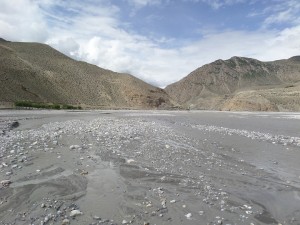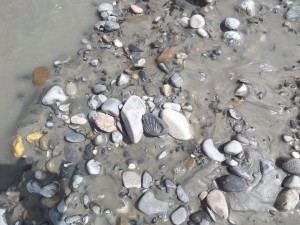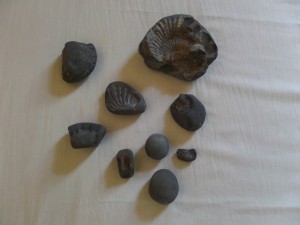We arrived in Kagbeni suitably rattled from a little over two hours in a cramped jeep that had been careening skillfully through narrow mountain roads and down steep, rocky, slopes ever since leaving Ranipauwa only about 15 miles behind us. On reflection, the entire trip between Muktinath and Kagbeni reminded me of some of the more terrifying amusement park rides I have experienced (sans the reassurance of safety harnesses, however), but I was grateful to finally get the chance to explore the famed Kali-Gandaki River valley.
This morning, my guide and I joined up with a few Hindu pilgrims and a number of sadhus (ascetic holy men) already making their way down to the river banks to begin the search for sacred Shaligrams. At this point in the season, it is only possible to remain outside in the valley during the morning hours, before the severe winds set in just after noon. We chatted amiably as our eyes scoured every inch of muddy silt and blackened waters. We talked about which stones we hoped to find and here and there about the proper methods of caring for Shaligrams once we found them, but more than anything what we talked about was mobility. This might sound like an odd topic of conversation, but I was surprised to discover that for many pilgrims, the idea that one can simply up and leave one’s house and family (or any number of reasons) was intensely important. What I would come to realize later, was that in many of the discussions I have had with pilgrims, with sadhus, and just with fellow travelers out for a new experience, it was mobility that was the true key to power.
In South Asia, mobility is sovereignty. For example, one Hindu pilgrim I held in conversation for some length told me that he had originally planned his current pilgrimage to start with looking for Shaligram stones in Kagbeni and then to spend 10 days traveling to the Damodar Kund (a lake that lies at 8000 meters in Upper Mustang that is the source of the Kali-Gandaki river and therefore the source of the Shaligram Stones). But he was angry now to learn that because he held a foreign passport, he would not be able to cross the restricted border to Upper Mustang. “The government should never interfere with pilgrimage.” he explained. “I’m thinking I might burn my passport, dump my belongings, dress as a sadhu, and just walk there myself anyway. I know many people who have done that, and the government can’t do anything.” When I responded with a measure of surprise, he clarified, “Oh, they might catch me on the way back, but that’s Ok. I’ll have already made it to Damodar, I will have my Shaligram, and what can they do? Deport me? Fine, free ride home.”
I know now how I will link the problem of national unity with mobility, power, and the Shaligram Stones. I now think that my first hypothesis was close, but ultimately incorrect. The Shaligram Stones are not just a marker of a landscape that is simultaneously a sacred landscape and a physical/every-day landscape, they are the markers of a conflict between the sacred landscape and the political one. And what is at stake isn’t just identity (national or religious), it’s the very possibility of sovereignty itself.




It is just so awesome what you guys are doing! Remembering you as our diennr partners for a month, it now seems surreal what you are all experiencing while we carry on with life here at home in Winnipeg. I truly admire your stamina, enthusiasm and courage.God bless and protect you.Abe